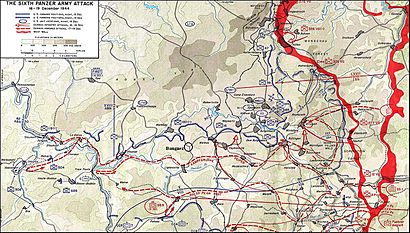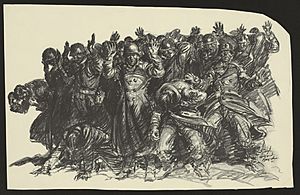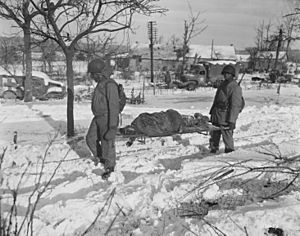Malmedy massacre facts for kids
Quick facts for kids Malmedy massacre |
|
|---|---|
| Location | Malmedy, Belgium |
| Coordinates | 50°24′14″N 6°3′58.30″E / 50.40389°N 6.0661944°E |
| Date | December 17, 1944 |
| Attack type | Mass murder by machine gun and gun-shots to the head |
| Deaths | 84 U.S. POWs of the 285th Field Artillery Observation Battalion and hundreds of other U.S. POWs from other units |
| Perpetrator(s) | 1st SS Panzer Division Leibstandarte SS Adolf Hitler
|
The Malmedy massacre was a terrible war crime that happened during World War II. On December 17, 1944, soldiers from a German group called the Waffen-SS killed many American prisoners of war (POWs). This happened near the town of Malmedy, Belgium, during a big battle known as the Battle of the Bulge.
The Waffen-SS soldiers gathered the American POWs in a field. They then used machine guns to shoot them. Any prisoners who survived the shooting were then killed with a single shot to the head. The term "Malmedy massacre" also includes other similar killings of civilians and POWs by the Waffen-SS in nearby Belgian towns. These crimes were later investigated in trials after the war.
Contents
Why did the Malmedy massacre happen?
The German plan for the Battle of the Bulge
The Malmedy massacre happened because of a big German attack called the Battle of the Bulge. This battle started on December 16, 1944. The German leader, Hitler, wanted his soldiers to fight very brutally. He ordered them to show no mercy, just like they did on the Eastern Front against the Soviet Union.
The main goal of the German attack was for the 6th Panzer Army to break through the Allied lines. They wanted to cross the River Meuse and capture the city of Antwerp. This was a very important port city.
A special German fighting group, called Kampfgruppe Peiper, was the main attacking force for this plan. Their job was to advance quickly with tanks and armored vehicles. They needed to capture bridges over the River Meuse. However, the roads they had to use were not strong enough for their heavy tanks. This caused delays.
American soldiers slow down the German advance
The Germans were surprised by how much the American army fought back. In one village called Lanzerath, a small group of 22 American soldiers fought against about 500 Waffen-SS paratroopers. This small group held up the German tanks for almost a whole day.
This delay was very important. It gave the U.S. Army more time to bring in extra soldiers and prepare for the German attack. Even though the American platoon eventually ran out of ammunition and was captured, their brave stand slowed down the powerful Kampfgruppe Peiper.
Killings before Malmedy
On December 17, 1944, the German tanks were already many hours behind schedule. They captured a town called Honsfeld. Here, the German soldiers went off their planned route to get fuel in Büllingen. In Büllingen, the Waffen-SS soldiers killed many American prisoners of war.
After this, the German group continued west. The roads were bad, making it hard for their heavy vehicles to move. They ended up turning towards a crossroads called Baugnez. This crossroads was close to Malmedy.
The massacre at Baugnez crossroads
Around noon on December 17, 1944, Kampfgruppe Peiper arrived at the Baugnez crossroads. At the same time, a convoy of American vehicles was also at the crossroads. These American soldiers were from the 285th Field Artillery Observation Battalion.
The Germans saw the American convoy first. They quickly fired at the first and last vehicles, stopping the whole convoy. Since the American soldiers were outnumbered and outgunned, they surrendered to the Waffen-SS.
After this short fight, the German tanks continued their advance. But the Waffen-SS infantry gathered the captured American soldiers in a nearby farmer's field. There were about 120 American POWs in the field.
Suddenly, the Waffen-SS soldiers opened fire with machine guns on the grouped prisoners. Some POWs tried to run away, but most were shot where they stood. Some American soldiers fell to the ground and pretended to be dead.
After the shooting stopped, the Waffen-SS soldiers walked among the bodies. They looked for anyone still alive and shot them in the head. Some POWs had hidden in a nearby café. The Waffen-SS then set the café on fire, killing any American POWs who tried to escape the flames.
Who was responsible?
It is not fully clear who gave the direct order to kill the American POWs at Malmedy. Both Joachim Peiper, the leader of Kampfgruppe Peiper, and Werner Poetschke, another commander, were considered responsible. Many people who were there said Poetschke gave the order. Even if Peiper didn't give the exact order, he was in charge. He was responsible for the way his unit acted and for creating a culture where taking prisoners was seen as a problem to avoid.
How the massacre was discovered
Later that same day, 43 American POWs who had survived the Malmedy massacre came out of hiding. They found help and medical care in the nearby town of Malmedy, which was controlled by the U.S. Army. The first survivors were found by an American patrol around 2:30 p.m.
News of the Malmedy massacre quickly spread through the U.S. Army. Soon, unofficial orders were passed around: do not take any SS soldiers as prisoners. This led to other incidents, like the Chenogne massacre, where American soldiers later killed German POWs.
Finding the bodies and investigating
The area where the massacre happened was behind German lines until January 13, 1945. On January 14, the U.S. Army reached the killing field. They found the frozen bodies of the 84 American POWs who had been killed on December 17, 1944.
Military investigators took photos of the scene and the bodies. The bodies were then taken away for examination and burial. The investigation looked closely at the gunshot wounds to help with future trials against the German soldiers.
They found that 20 of the 84 bodies had gunpowder burns on their heads. This showed they were shot at very close range, likely a single shot to the head to make sure they were dead. Other bodies had different types of head wounds, including some from being hit repeatedly with rifle butts. Most of the bodies were found in a small area, which proved that the Germans had gathered the POWs together before shooting them.
How many were killed?
After the war, a U.S. Senate investigation looked into the Malmedy massacre. It concluded that soldiers from Kampfgruppe Peiper killed between 538 and 749 U.S. POWs during the Battle of the Bulge. Other investigations gave lower numbers, saying between 300 and 375 U.S. soldiers and 111 civilians were killed by Kampfgruppe Peiper.
See also
- List of massacres in Belgium
- Wereth Massacre, where 11 African-American prisoners of war were tortured and killed by the 1st SS Panzer Division on the same day.
- Chenogne massacre, a similar massacre carried out by American soldiers 15 days later.
- Normandy massacres, a series of killings where Canadian prisoners of war were murdered by German soldiers during the Battle of Normandy.




